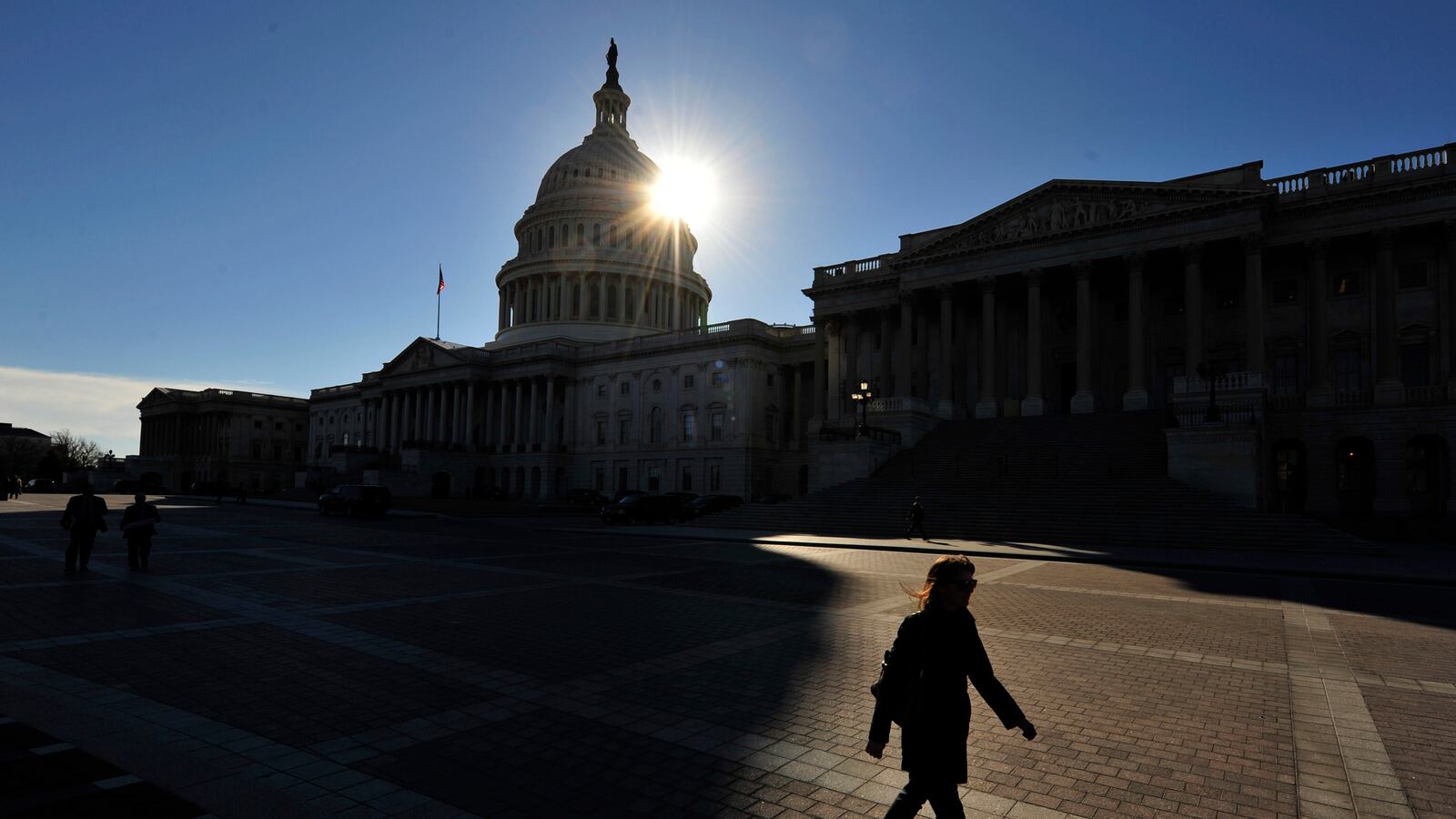At least when Nero fiddled, Romans got to hear music over the flames.

But while Congress has enjoyed a midwinter vacation as the sequester deadline comes closer, the American people have been treated only to the sight of a slow-motion car crash combined with finger-pointing. Impact is scheduled for this Friday, yet the mood in Washington is resignation—an impotent shrug in the face of self-inflicted disaster.
The sequester is, as CNN’s Ali Velshi memorably said, “a stupid name for a stupid idea that could have only come from Washington.”
But there are still a few folks pushing for a solution to the problem. After all, the sequester was first proposed as a massive stick to contrast with any reasonable carrot: it was supposed to be painful punishment in retaliation for a failure to reason together.
But fear of distant political pain could not compel cooperation in congress. And now the clock has almost run out. If the “meat ax” cuts that almost no one says they want to take place are enacted—$1.2 trillion dollars over 10 years, starting with $85 billion this year—we could see the American recovery pushed into reverse.
President Obama has previously set a goal of a 2-to-1 ratio of spending cuts to new revenue as the outline of a bipartisan deal, but he is now also calling for a two-month delay in sequester cuts, to create more time for grand bargain-style negotiation to coincide with the debt ceiling hike that is expected in May. Kicking the can isn’t pretty, but there’s little hope for a grand bargain in the next week.
At this moment of maximum drama—with Congress finally coming back to work Monday, and the ax due to fall Friday—what are possible solutions? The list is limited and often contradictory, but it provides a menu of options that is worth reviewing, because some action is better than none, and because there are some common ideas that could help point the way to an eventual understanding that moves us past government by artificial crisis and the current game of chicken.
Writing in The Wall Street Journal, Karl Rove proposed that the current sequester cuts go forward as scheduled with one major shift: he is arguing that Republicans in Congress vote to give the Obama administration the discretion necessary to make the cuts more intelligent, instead of subjecting efficient and inefficient programs alike to indiscriminate cuts. While some Republicans will oppose giving the Obama administration more control over what to cut, some Democrats oppose the move because it sets a potential political trap where the president will be forced to own the inevitably unpopular specific cuts. These political considerations are less important than the fact that justice is related to discretion—the cuts will be smarter if they are guided by the good judgment that comes from owning implementation.
Senate Democrats are offering an alternative they called the American Family Economic Protection Act that finds $110 billion in savings over the next year, split between spending cuts and new tax revenue. The $55 billion in cuts would be split evenly between defense and agriculture, ending direct payments to farmers that are paid regardless of crop prices or farm income. The $55 billion in revenues would come from implementation of the so-called Buffett rule that Obama trumpeted throughout the campaign, which would require individuals with incomes over $1 million a year to pay a 30 percent income-tax rate. This plan has the virtue of relative simplicity, but is considered a nonstarter with Republicans.
House Republicans argue that they have already passed an alternative to sequestration, but their existing plan barely passes the laugh test, as it proposed exempting defense from the cuts entirely and thus gutting domestic spending, making it an intentional nonstarter with Democrats. That said, House Majority Leader Eric Cantor’s office released an interesting list of cuts that could be enacted, focused primary on the always-popular category of reducing waste, fraud, and abuse as well as selected entitlement reforms. It is a political document, full of contestable characterizations, but it provides some useful specifics to consider. But Cantor’s list itemizes only seven specific dollar-itemized program spending cuts that all told would save just $4 billion this year. His total wish list caps out at roughly $250 billion saved over 10 years—a significant amount, but far below the $1.2 trillion over 10 years needed to match the sequester.
Not surprisingly, House Democrat proposals are focused on what revenues can be raised through closing loopholes. The most politically popular targets for Democrats include a deduction for private jets (which could raise an estimated $3 billion) and oil and gas exploration tax subsidies that date back to the earliest days of the industry (which could raise $21 billion). The tax break for companies moving operations overseas is justifiably outrage provoking, but ending it would raise less than $1 billion dollars. Some substantive congressional discussion is finally occurring about ending the carried-interest loophole, which allow hedge-fund owners to have their income taxed at lower capital-gains rates—despite that the profits have come from investing other people’s money rather than their own. Closing this loophole could raise $21 billion over 10 years, according to the CBO. Democrats like Steny Hoyer are pushing a plan to cap itemized deductions to 28 percent of an individual’s income, which would raise $300 billion over 10 years.
Harvard professor Martin Feldstein—chairman of the council of economic advisers under Reagan—has advocated for an alternative approach, which would place a 2 percent cap on tax deductions and exclusions, which could save $2.1 trillion over 10 years, even if all charitable deductions were exempted from the cap.
But Senate Minority Leader Mitch McConnell has said that concessions were made on higher tax rates as part of the last-minute fiscal-cliff deal, and that door is now closed. And while lowering corporate tax rates by closing loopholes is a proposal both Obama and Republicans have backed in the past, the dirty little secret is that corporate lobbyists who have influence with both parties worked hard to lard up the system and don’t necessarily support a simpler corporate tax code that could cost their clients.
Finally, there is the issue of entitlement reform—often discussed and little enacted. In his State of the Union, President Obama said, “Those of us who care deeply about programs like Medicare must embrace the need for modest reforms.” He specified: “we’ll reduce taxpayer subsidies to prescription-drug companies and ask more from the wealthiest seniors”—which sounds like an endorsement of increasing means testing for Medicare recipients. In past negotiations, the president has also indicated support for changing the formula for Social Security payments. These are all steps in the right direction that could be the basis for some bipartisan agreement.
Consider all these specifics, and you’ll quickly see that outside the positional bargaining, there is room to find common ground. There are areas of overlap, but they will only be acted upon in the context of a grand bargain, where spending cuts, tax reform that closes loopholes to raise revenue, and entitlement reform are achieved.
Amid the pervasive cynicism of Washington, there is still the impulse to avoid as much political pain as possible and wait for the next election. But that attitude is what has brought us to this latest brink. Beyond the coming sequester deadline, we face the possibility of a government shutdown in March and another debilitating debt-ceiling debate in May.
“The best thing we could do would be to replace the blunt sequester with a comprehensive debt deal that focuses on entitlement and tax reform—we should start where Obama and Boehner left off, and build up,” says Maya MacGuineas, the president of the nonprofit, bipartisan Committee for a Responsible Federal Budget. “The worst would be to just waive it and come up with no savings at all. The mediocre solutions in between from offsetting the one year costs over 10 years, to delaying the sequester for another few months, all reflect politicians’ never-ending desire to run from the difficult policy choices we so desperately need to face. The sequester was developed to force action—they should act. Instead of lurching from one near crisis to the next, they should just get to work and deal with the nation’s fiscal challenges once and for all.”
One week isn’t enough time to solve all these problems, but we can’t afford to wait much longer for a comprehensive plan. Pick and choose from the items of this policy buffet—but Congress better come back from their latest break tan, rested, and ready to work across the aisle. Because right now Washington gridlock is the greatest threat to the still-fragile American recovery.





